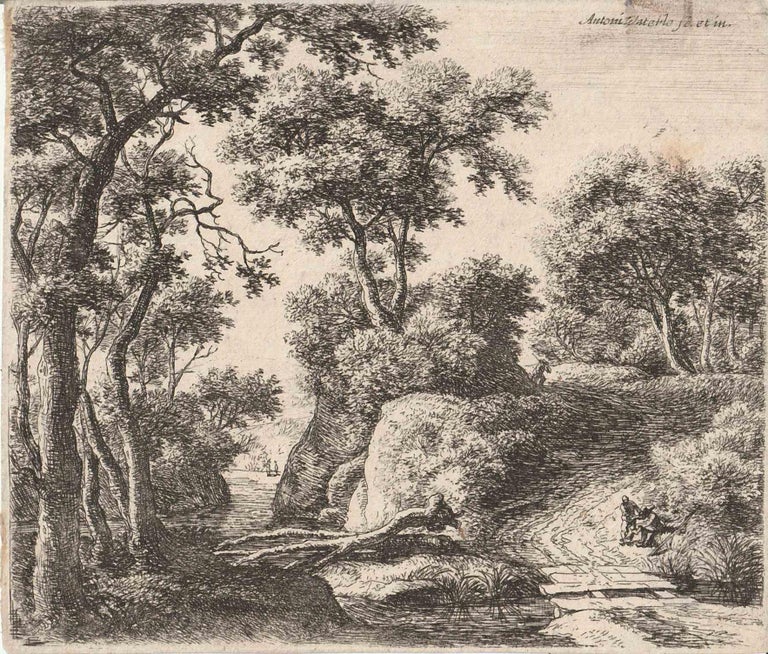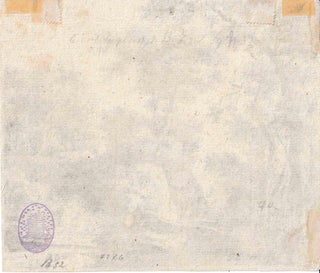The Plank Bridge; Landschap met een bruggetje van planken
1650. Etching on thin cream laid paper with a partial "M" or "W" watermark, 5 x 5 15/16 inches (126 x 150 mm), thread margins. Inscribed in the plate in the upper-right: “Antoni Waterlo fe. et in.” In very good condition with light toning in the top right and left corners, at the location of a former mount, and scattered inscriptions in pencil on the verso. With a charming ovoid beehive collectors stamp in purple ink on the verso (Lugt 2732). Because this impression lacks the additional cross hatching and vertical shading on the trunk of the large tree in the left portion of the image, and the mound of earth in the left-center sheet, it is our opinion is that this is a first state impression (of two), and before the 1776 publication by Basan. A comparable impression may be found in the collection of the British Museum. Plate six from the series, “Six Landscapes."
[Bartsch 52.1; Hollstein 52].
On the collector's stamp, taken from Frits Lugt, Les Marques de Collections de Dessins & d’Estampes Fondation Custodia:
"We have not found the owner of this mark, the name of which must probably be related to what it depicts, a beehive, which could symbolize a concentration of elements around a collection. For us, it evokes the words of the great art historian Henri Focillon, who wrote in the preface to the catalog Le Dessin français dans les collections du XVIIIe siècle (Paris 1935): "It is because the particular genius of the collector consists, by the certainty of discernment and by the personality of choice, to make, with the genius of others, a honey that belongs only to him. » In the margin of the copy of Frits Lugt's book, The Marks of Collection of Drawings & Prints (1921), from the Galerie Karl & Faber in Munich, it is written "Slg. Moran” opposite number L.2732, with a reference to the Supplement (1956), p. 409. In the latter there is indeed a note at the end of the objects section: “Bienenkorb mit und ohne Initial “M”: Slg. Moran, Berlin”. But we have not yet found any information on this Moran collection, from Berlin, which would perhaps allow us to identify this amateur beekeeper. A landscape drawing attributed to Theodorus Wilkens, sold on the art trade at Christie's in Amsterdam on November 14, 1984 under number 130, was presented in the auction catalog as coming from a "Moran collection, Berlin, its mark not mentioned in the Lugt”. It reappeared in 2004 in the catalog of the Winterberg house, in Heidelberg, Meisterzeichnungen aus fünf Jahrhunderten, under number 21, and this time noted as coming from “anonymous collection L.2732”. The joint presence on several drawings and prints of this mark L.2732, associated with the name “Moran”, and of the unidentified mark L.4218, M in capital letter followed by a point, both stamped in purple ink, encourages us to write that these two brands are linked to the same collection. They are found stamped on several prints: for example on a mezzotint by Wallerant Vaillant (sale 1995, November 28, London, Christie’s, n° 336); on an etching by Daniel Chodowiecki (sale 2001, June 7, Hamburg, Hauswedell & Nolte, no. 139); on an engraving by Pieter II de Jode after J. Jordaens (sale 2004, November 24 and 25, Haarlem, Bubb Kuyper, no. 3485); on three burins by Hans Sebald Beham from the series Les Noces de village (B. 157, B. 161, B. 162; sale 2016, March 22, London, Sotheby’s, no. 21). They are still together indicated on an etching by Breenbergh bearing in particular the mark of the doubles of the Kupferstichkabinett in Berlin, L.2398 (archives of the Fondation Custodia, January 9, 2016). They are also stamped together on the mount of a wash attributed to Bartholomeus Breenberg (sale 1998, November 9, Amsterdam, Christie’s, n° 102). The L.2732 mark, alone, has also been reported on old prints: La Sainte Famille by Bartolommeo Biscaino (sale 1987, December 8 and 9, Berlin, Bassenge, Auktion 50, n° 4044); a Shepherd and his herd walking by Gerrit Claesz Blekker bearing the marks of Cabinet Brentano-Birckenstock, L.345, and of J. Pricken, L.2049 (B. 9; id., n° 4045); Empedocles by René Boyvin after Rosso (id., no. 4072); three woodcuts by Albrecht Dürer (B. 76, B. 82 and B. 86; sale 2007, March 28, London, Christie’s, nos. 61, 62 and 65). It has also been reported, alone, on drawings: sale 2000, November 24 and 25, Berlin, Bassenge, Auction 76, n° 5647 as Wilhem F. Schlotterbeck (1777-1819); sale 2014, June 14, Hamburg, Hauswedell & Nolte, n° 556 as Jan Hackaert. We also do not know why Lugt proposed the name of Zeidler, of Nuremberg, in the 1921 notice, except that the coat of arms of the bibliophile Carl Sebastian Zeidler (1719-1786) presents a beehive, and the word 'zeidlerei' being an old name to indicate the collection of honey."
Item number: 502
Price: $2,750.00
Share:

